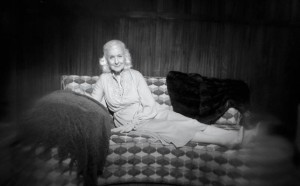STUDIO: Criterion | DIRECTOR: Guy Maddin | CAST: Ann Savage, Darcy Fehr, Amy Stewart, Louis Negin, Lou Profeta
RELEASE DATE: 1/20/15 | PRICE: DVD $29.95, Blu-ray $39.95
BONUSES: short films, outtakes, short “cine-essays” on Winnipeg, My Winnipeg Live in Toronto featurette, Maddin interviewed by art critic Robert Enright
SPECS: NR | 80 min. | Documentary | 1.33:1 widescreen | 2.0 Surround
Although Guy Maddin’s earliest features, starting with his 1988 debut Tales from The Gimli Hospital, were inspired primarily by silent cinema and early European talkies, in the last decade he has layered onto that influence a very heavy dose of playful avant-garde experimentation. In the uncategorizable 2007 film My Winnipeg, he blends fiction and fact about his hometown while melding silent-movie visuals with avant-garde composition and editing — not forgetting his usual absurd, deadpan humor.
In one of the many supplements included here, which run approximately a half-hour longer than the film proper, My Winnipeg is referred to as a “docu-fantasia.” This is about as accurate a label as the film can possibly have, since it is a humorous and affectionate essay that uses real Manitoba history and personal Maddin mythology to explain his deep love of his legendarily freezing city.
Maddin narrates the film in an emphatic style, telling us how he longs to leave Winnipeg for good, but never has. As he imparts nuggets of the city’s “history,” he conducts an experiment (fictional) in which he decides to shoot part of the film in his childhood home with actors playing himself and his siblings, and his mother playing herself (again, fictional — Detour star Ann Savage plays the role).
The film thus forms the third part of an unofficial trilogy (after Cowards Bend the Knee and Brand Upon the Brain!) in which Maddin has examined his family life through a very odd lens. Here his reminiscences about his family’s obsessions are situated within the larger context of real events in Winnipeg history (a labor strike that crippled the city, a “What If?” day in which Winnipeggers staged a fake Nazi invasion to see how they’d deal with Canada entering into WWII) and a number of Guy’s own obsessions that he informs us are hallmarks of the city.
 Many of the cornerstone works of surreal and avant-garde cinema have toyed with Freudian symbols and archetypes, but Maddin’s autobiographical films are awash in them. Here Winnipeg is a sort of dream community in which the citizens sleepwalk, carry keys to houses they no longer live in, travel down snowy alleyways between houses, court each other while sitting on the heads of dead horses that are submerged in ice, and (best of all) are addicts for a TV show called “Ledge Man,” in which the protagonist is talked out of suicide in every episode.
Many of the cornerstone works of surreal and avant-garde cinema have toyed with Freudian symbols and archetypes, but Maddin’s autobiographical films are awash in them. Here Winnipeg is a sort of dream community in which the citizens sleepwalk, carry keys to houses they no longer live in, travel down snowy alleyways between houses, court each other while sitting on the heads of dead horses that are submerged in ice, and (best of all) are addicts for a TV show called “Ledge Man,” in which the protagonist is talked out of suicide in every episode.
The hypnotic dreaminess of the film is reflected by the fact that Maddin uses both narration and silent movie-style intertitles to tell his twisted tales. The layering he’s added here also includes a brilliant “save” of the sequences featuring Ann Savage, who gives an extremely flat performance as his mom. Situating her performance as an “effect,” Maddin includes failed takes in the film in which he is heard giving Savage the correct line readings. Thus her flatness doesn’t ruin the scenes she’s in, and My Winnipeg has an added, self-referential level (one that hasn’t appeared in a Maddin feature to date).
The supplements includes four short shorts by Evan Johnson, in which Winnipeg topics are dealt with (yes, “cold” is included). The key extra is a lengthy interview with Maddin about the film; art critic Robert Enright tries to clarify which of the elements in the film are real and which are Guy’s inventions. In the process Maddin cites his influences for the project, including Chris Marker (Level Five), Werner Herzog (Cave of Forgotten Dreams) and the “symphony of a city” films of the Twenties.
Perhaps the most striking supplements are three Maddin shorts that are visually compelling and completely non-narrative. For years his shorts have supplied a “laboratory” for techniques that he later used in his features, but here — although the topics range from very light (a walk with his dog) to very heavy (a study of his dead brother) — the films are purely experimental and seem divorced from his feature work, lacking as they do a storyline and humorous elements.
The extras confirm what My Winnipeg already indicated — that while Maddin likes to claim he’s mired in the past, his filmmaking has continued to mature with each production.
|
Buy or Rent My Winnipeg
|
|||
|---|---|---|---|
DVD |
 |
 |
|
Great review,Ed.
Take a look at this National Film Board of Canada short from 1953 (it runs nine minutes).I first saw it years ago on an NFB compilation DVD.
I have to think Guy Maddin must have seen this film at some time. It certainly looks like something he would make. It’s a gem.
https://www.nfb.ca/film/paul_tomkowicz_street_railway_switchman